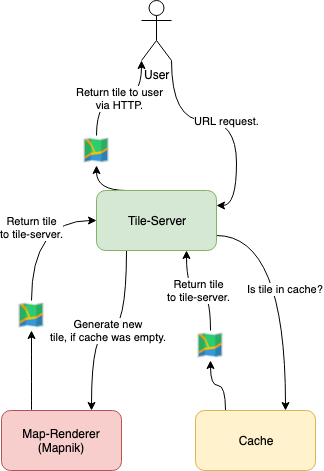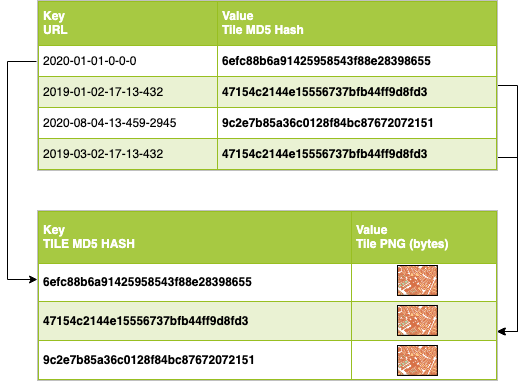Caching¶
Basic¶
There are 3 tings, that will be cached.
Mapnik Style XML for each date
tile cache location
tile
The cache will be filled on each HTTP request, where there is no cached file
or when using the prerendering command.:
$ docker-compose -f local.yml run --rm django python manage.py prerender [ZOOM_LEVEL]
Below is a diagram, how the cache is used in a view.

Fig. 16 Tile Server overview¶
Caching Objects¶
1. Mapnik Style XML for each date¶
Cache will be created, when a tile process is running. For each date, the system need a different mapnik style XML.
2. tile cache location¶
Cache location of a tile. To save space on the cache server, every tile will
be hashed with MD5 and saved under the MD5 value. When multiple tiles have
the same MD5 hash, then only one tile will be saved. The cache location key
is year-month-day-zoom-X-Y.

Fig. 17 tiles of a map¶
3. tile¶
Finally, the tile PNG. The cache key is the hash value of the tile.
Config¶
In the config file, you can set, how low the cache should be saved.:
# caching
# ------------------------------------------------------------------------------
# to which zoom level tiles should cached for ever
ZOOM_LEVEL=13
# 2592000 == 1 month
TILE_CACHE_TIME=2592000
ZOOM_LEVEL to which zoom level the cache should be stored for ever.
TILE_CACHE_TIME how long a tile should be cached in seconds.
Caching Objects¶
To clear up all cached files use:
$ docker-compose -f local.yml run --rm django python manage.py clear_cache
But be careful, this command can’t be undone!
Compression¶
To save space on the cache system, any cache object will be compressed with lzma.
For changing the compression mode, modify config/settings/production.py under
CACHES. On https://docs.python.org/3/library/lzma.html#module-lzma is a list,
with all available compression modes.